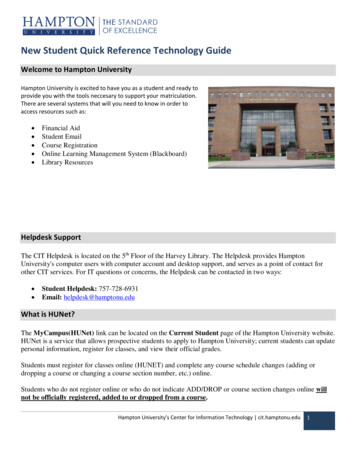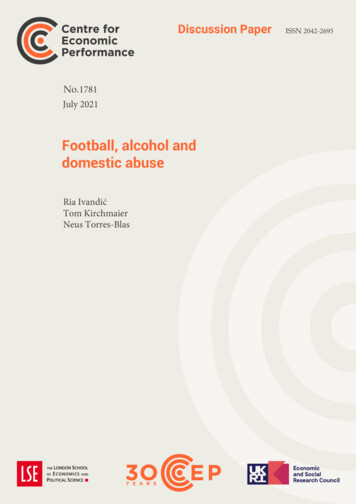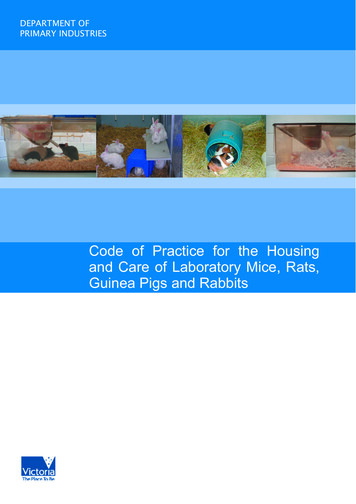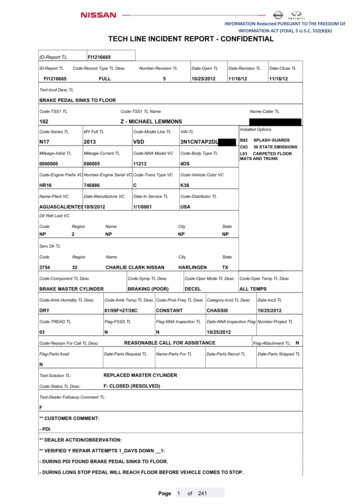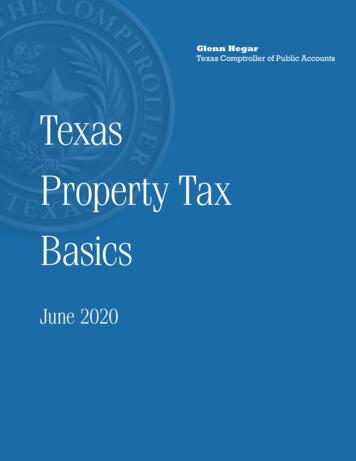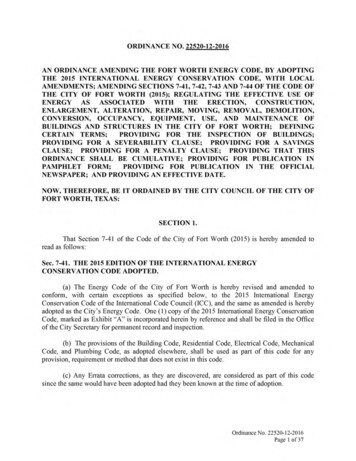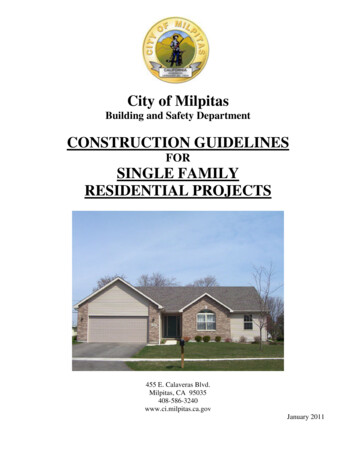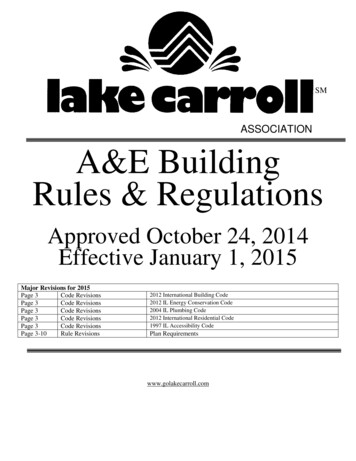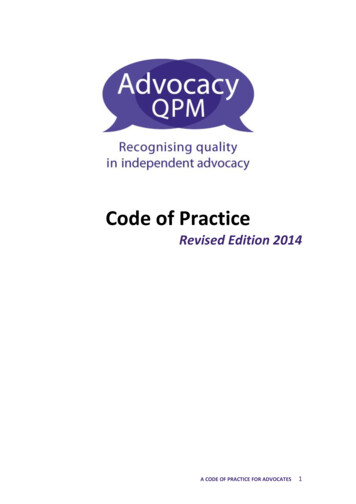
Transcription
Code of PracticeRevised Edition 2014A CODE OF PRACTICE FOR ADVOCATES1
ContentsPage1. Introduction . 32. The Advocacy Charter . 53. The Code of Practice . 74. References . 19A CODE OF PRACTICE FOR ADVOCATES2
IntroductionPeople are entitled to be in control of their own lives but sometimes, whetherthrough disability, financial circumstances or social attitudes, they may findthemselves in a position where their ability to exercise choice or represent their owninterests is limited. In these circumstances, independent advocates can help ensurethat an individual’s rights are upheld and that views, wishes and needs are heard,respected and acted upon.The Advocacy CharterThe Advocacy Charter was published in July 2002 by Action for Advocacy and set outto define and promote key advocacy principles. The Charter provides advocacyschemes and others with a vehicle for both explaining what advocacy is and outlininga common vision of what constitutes effective advocacy. The Advocacy Charterprinciples and the Code of Practice have been revised in 2014, by EmpowermentMatters CIC and the National Development Team for Inclusion (NDTi), to reflectchanges in legislation as well as developments in advocacy practice.What is the Code of Practice?The Code of Practice is a set of guidelines for advocates and their managers, aimedat providing clarity, support and boundaries for their practice. It is also a guide forcommissioners of advocacy services that outlines the expectations and purpose ofthe role and what clients as well as commissioners should expect from the deliveryof the service. The Code provides a clear description of what is and is not expectedof an advocate in their day-to-day work with clients.An effective Code of Practice can:Offer guidance to advocates in their roleInform clients of what they can realistically expect from theiradvocate/advocacy serviceEducate health, social care, third and private sector services, commissionersand others about the scope and limitations of the advocate’s roleHelp to develop a better understanding of the training, supervision andsupport needs of advocatesRaise awareness of the need for and benefits of independent advocacy forvulnerable peopleA CODE OF PRACTICE FOR ADVOCATES3
Definition of advocacyAdvocacy is taking action to help people say what they want, secure their rights,represent their interests and obtain services they need. Advocates and advocacyproviders work in partnership with the people they support and take their side.Advocacy promotes social inclusion, equality and social justice.Definition of non-instructed advocacyNon-instructed advocacy takes place when a person lacks the capacity to instruct anadvocate.1The non-instructed advocate seeks to uphold the person’s rights; ensure fair andequal treatment and access to services; and make certain that decisions are takenwith due consideration for all relevant factors which must include the person’sunique preferences and perspectives.1An individual might be able to express what they want, e.g. to go home, state what they like or dislike,but may lack the capacity to instruct an advocate as to the action to take regarding a particular issue.A CODE OF PRACTICE FOR ADVOCATES4
The Advocacy CharterDefining and promoting key advocacy principlesCLARITY OF PURPOSEClarity of purposeThe advocacy provider’s aims, objectives and planned activities are within theobjects set out in its governing document and providers should be able todemonstrate how these meet the principles contained in this Charter. Advocacyproviders should ensure that the people they advocate on behalf of, health andsocial care services and funding agencies have information on the scope andlimitations of the advocacy provider’s role.IndependenceThe advocacy provider will be structurally independent from statutory organisations.The advocacy provider will be as free from conflict of interest as possible, both indesign and operation of advocacy services, and seek actively to reduce conflictinginterests, in particular where the organisation provides additional services such ashousing provision.Person Centred ApproachThe advocacy provider will ensure that the wishes and interests of the people itadvocates on behalf of direct its work. Advocates should be non-judgmental andrespectful of people’s needs, views, culture and experiences.EmpowermentThe advocacy provider will support self-advocacy and empowerment through itswork. People who access the service should have a say in the level of involvementand style of advocacy support they want where they are able and wish to. Whereclients lack the ability or capacity to influence the service, the advocacy providershould have a process in place to enable those with an interest in the welfare of theperson to influence this. Providers will ensure that people who want to, caninfluence and be involved in the wider activities of the organisation up to andincluding at Board level.UAL OPPORTUNITYEqual OpportunityThe organisation will have a written equal opportunities policy that recognises theneed to be pro-active in tackling all forms of inequality, discrimination and socialexclusion. The advocacy provider will have systems in place for the fair and equitableallocation of advocates’ time.AccessibilityAdvocacy will be provided free of charge to eligible people. Where clients need orwant to purchase advocacy or where someone has an appointed deputy/attorney inplace who wishes to instruct an advocate on the person’s behalf, suitable processesshould be in place to safeguard the person and ensure they are not open to financialabuse. The advocacy provider will aim to ensure that its premises (whereA CODE OF PRACTICE FOR ADVOCATES5
appropriate), policies, procedures and publicity materials promote access for thepopulation that it serves.Supporting advocatesThe advocacy provider will ensure advocates are suitably prepared, trained andsupported in their role and provided with opportunities to develop their knowledge,skills and experience.AccountabilityThe advocacy provider will have systems in place for the effective monitoring andevaluation of its work, including identification of outcomes for people supported. Allthose who access the service will have a named advocate and a means of contactingthem.ConfidentialityThe advocacy provider will have a written policy on confidentiality that is in line withthe Data Protection Act 1998 and the Mental Capacity Act 2005. It should outlinehow information about a person accessing the service may be shared as well as thecircumstances under which confidentiality might be breached. Advocates must alsobe aware of situations that would require making a child or adult safeguarding alert.ComplaintsThe advocacy provider will have a written policy describing how individuals,including relevant stakeholders, can make complaints or give feedback about theservice or about individual advocates. Where necessary, the organisation will enablepeople who use its services to access external independent support to make orpursue a complaint.SafeguardingClear policies and procedures will be in place to ensure safeguarding issues areidentified and acted upon. Advocates will be supported to understand the differentforms of abuse and neglect, issues relating to confidentiality and what to do if theysuspect a client is at risk.A CODE OF PRACTICE FOR ADVOCATES6
Code of PracticeClarity of purpose1. Advocates should be clear about the nature and extent of their role. Theyshould understand the boundaries of their own advocacy role and nonadvocacy roles such as mediation and advice giving.2. Advocates should not act outside of these boundaries. Advocates should seekpermission (where the client has the capacity to consent or refuse) to referpeople on to other agencies where appropriate.3. Advocates should refer clients who lack capacity to consent to otherappropriate services, including other advocacy providers, whereappropriate/in their best interests (in accordance with the Mental CapacityAct 2005).4. Advocates should be able to explain, in straightforward language, whatadvocacy is and isn’t; why some people need advocacy; where people have astatutory right to access advocacy; where there is a statutory duty placed onthe NHS or Local Authority to instruct an advocate; and the benefits advocacycan bring. They should be equipped to answer questions and deal withenquiries about advocacy.5. Advocates should be responsible for providing clients with a clearexplanation of their role at the start of any new relationship, which shouldinclude providing easy to read materials where this is required.6. Advocates should provide written information about their organisation and acopy of the Code of Practice to clients, carers or other professionals ifrequested.A CODE OF PRACTICE FOR ADVOCATES7
Independence1. Advocates should be able to describe how they are independent from otherservice providers.2. Advocacy providers should ensure there is a service level agreement wherethey receive funding from the local authority or other organisation thatprovides services that are not advocacy e.g. domiciliary care or supportedhousing. This should make clear that the advocacy provider is independentfrom the other organisation.3. Advocacy providers should have suitable policies and processes in place thatsupport them to challenge decisions made on behalf of their clients bypractitioners working in health and or social services.4. Advocates should take all appropriate steps to avoid conflicts of interestoccurring in their work with clients. Where a conflict of interest does arise, itshould be declared to the line manager and advice should be sought as tohow to proceed.5. Advocates should be free to act according to the wishes and needs of clients.They should not be compromised through requirements of contracts to act ina certain way that is not in line with advocacy principles or other guidancesuch as the Mental Health Act 1983 Code of Practice; Mental Capacity Act2005 Code of Practice or Advocacy Code of Practice whilst carrying out theirduties. Where this occurs, it should be reported to the line manager at theearliest opportunity.A CODE OF PRACTICE FOR ADVOCATES8
Person Centred Approach1. Advocates should ensure advocacy support is appropriate to the client’sneeds and/or expressed wishes.2. Advocates should take instruction from clients where they have the capacityto instruct or take instruction from a third party where the client lackscapacity to instruct.3. Advocates should base their actions on mutually agreed plans and preferredoutcomes, and work in partnership with clients to achieve this.4. Where advocates are acting in a non-instructed role their actions should beguided by the framework of the Mental Capacity Act 2005, the Mental HealthAct 1983 (where applicable) and the recognised approaches to noninstructed advocacy.5. The advocacy provider should have clear policies and processes that outlinethe model of advocacy that they deliver and which guide the advocacy roleincluding:Prioritisation policyNon instructed advocacy policyReferral/instruction forms that include third party referral optionsForm of authority (for use in both instructed and non instructed advocacy)The advocacy role may include:Instructed Advocacy:Gathering and presenting up to date and accurate information to help clientsmake informed choices but NOT giving advice.Listening to clients and discussing options but NOT imposing views oropinions.Channelling clients wishes, views and requested instruction, NOT filteringthem e.g. due to personal views that the client will not achieve what theywish.Talking to and corresponding with family members or other professionalswith the client’s permission but NOT making decisions or choices on behalf ofclients.Representing the client’s expressed views and wishes but NOT taking actionindependently of the client unless they have clearly instructed this.Agreeing a plan of action and identifying initial outcomes and timescales withclients but NOT being prescriptive or inflexible.Ensuring the person’s fundamental human rights are respected and upheld atall times.Challenging health, social care or third sector service providers and decisionmakers in order to promote a person-centred approach.Non-instructed advocacy:Where a client lacks the capacity to instruct, using the recognised models ofnon-instructed advocacy which include:- Person centred approach- Witness observer approachA CODE OF PRACTICE FOR ADVOCATES9
- Rights based approach- Watching briefQuestioning approachUsing the framework of relevant legislation to guideand underpin the advocacy role including the Mental Capacity Act 2005 (5statutory principles and best interests checklist); Mental Health Act 1983;Human Rights Act 1998; Equality Act 2010; Data Protection Act 1998 and anyother relevant legislation or guidance.Spending time with the person in order to get to know them and building apicture of their preferences, wishes, views, circumstances, lifestyle and theircultural or religious background.Seeking appropriate alternative forms of communication, which enable theclient to express wishes, views and choices.Ensuring the person’s fundamental human rights are respected and upheld atall times.Following the process of supported decision making to ensure the client is asinvolved in decisions about them as much as possible.Challenging health, social care or third sector service providers and decisionmakers in order to promote a person-centred approach.Other forms of advocacy may also include:Peer AdvocacyGroup AdvocacySelf AdvocacyA CODE OF PRACTICE FOR ADVOCATES10
Empowerment1. The advocacy provider should have empowerment at the heart of theirservice delivery and carry out the following actions to ensure clients are asactive and present in decisions that are being made about them as theypossibly can be:2.3.4.5.6.Promoting and delivery of self-advocacy tools/models.Promoting supportive decision-making to ensure the client is at the heart ofdecisions about their own care and support.Recording the outcomes achieved by an advocacy client.Promoting the person’s rights within decision-making meetings andhighlighting relevant guidance and legislation that underpins this.Agreeing on methods of advocacy representation where the client is able toinstruct the advocate to ensure they have a say in their own lives andbecome enabled to access relevant services.Use the framework of the Mental Capacity Act 2005 and recognised modelsof non-instructed advocacy where the person lacks capacity to makeparticular decisions to ensure the person has a say in their own lives anddecisions that are being made about them.Ensuring that the client has been referred appropriately and considering ifadvocacy is the best option or if another form of support would be moreappropriate (advice or information for example).Advocates should be able to explain to all clients what their rights andoptions are with respect to the specific decision at hand. Where the advocateis unable to do this either due to a lack of knowledge, skills or specificexpertise they should support clients to access the most appropriaterepresentation, advice or information e.g. via a solicitor, advice organisationor alternative specialist service.Advocates should inform clients of their right to request a change ofadvocate (within the constraints of the organisation), or terminate contactwith the advocate, at any time if a client is unhappy with the advocate’sapproach to a particular issue.Advocates should be open and transparent in their work with clients.Advocates should recognise the existing skills of clients, and support peopleto develop new skills and the confidence to speak for themselves.Advocates should provide clients with information about making a complaintabout the service or advocate.Advocates should provide clients with information about how they can givefeedback to the advocacy provider about its work and how to get involved inthe wider activities of the organisation if they wish/where this is an option.A CODE OF PRACTICE FOR ADVOCATES11
Equal Opportunity1. Advocacy providers should ensure that they are able to meet the needs ofthe population they serve and where this is compromised e.g. due to lack ofresources, this is raised with relevant stakeholders and/or funders.2. Advocates should be fully conversant with their organisation’s equalopportunities policy and be able to explain it to others in straightforwardlanguage. Advocates should adhere to this policy at all times.3. Advocacy providers should be aware of their duties and responsibilities underrelevant human rights and equality legislation including the Equality Act2010, Human Rights Act 1998 and other relevant wider policies that promotepersonalisation and person centred care and support.4. Advocates should counter/challenge any evidence of unfair or unequaltreatment and challenge discriminatory practice. Advocacy providers shouldensure there are systems in place that enable advocates to whistleblow,make complaints, make a safeguarding alert or seek legal advice whereappropriate.5. Advocates should be respectful of clients’ religious, cultural and spiritualneeds and be proactive in ensuring these are met. Where a client expresses apreference for advocates with particular skills, knowledge or attributes, thisshould be referred to the line manager.A CODE OF PRACTICE FOR ADVOCATES12
Accessibility1. Advocates should not make a charge to clients for their services where theyare funded directly to provide this service.2. Advocacy providers that charge for their service e.g. where someone has aproperty and affairs deputy or attorney who believes that advocacyrepresentation would be in the client’s best interests, must ensure there areappropriate safeguards and agreements in place that ensure the client is notvulnerable to financial abuse.3. Advocacy providers that charge for their services for clients who havecapacity to consent to this (e.g. because there is not appropriate fundingprovision in place) must ensure there are appropriate safeguards andprocesses in place to ensure the client is not vulnerable to financial abuse.This may involve approaching the local authority for specific funding orhaving a sliding scale of charges that are proportionate to a person’scircumstances.4. Advocacy providers should ensure there is information made publiclyavailable about their service and its remits on their websites and in writteninformation, in a format reflective of the needs of local client groups e.g. inother languages, Makaton, Easy Read, Braille etc.5. Advocacy providers should ensure there is a clear and accessiblereferral/instruction process for self-referrers as well as third parties.6. Advocates should ensure that clients are aware of when and how they can becontacted and any limitations to this contact (e.g. not at weekends).7. Advocates should respond positively to requests from clients to meet inplaces and at times, which are mutually convenient. Where necessary, theadvocate should make arrangements for accessible meeting places, which areacceptable to the client and/or setting they are in.8. Advocates should be fully conversant in their and other organisations’ (wherethey provide advocacy in a range of settings) risk management and healthand safety policies. Advocates should explain to clients when particularaspects of these polices impact upon when and where the advocate can meetthe client (e.g. in some secure settings).9. Advocates should make every effort to ensure that information they havegathered on behalf of the client is accessible and understandable to them.A CODE OF PRACTICE FOR ADVOCATES13
Supporting advocates1. Advocacy providers should ensure the following is available, and thatadvocates make full use of and contribute to:On-going relevant training and personal development opportunities.One to one casework supervision with the line manager or other appropriateidentified person who is suitably skilled and knowledgeable about the role ofadvocacy.Annual appraisal against agreed targets.Group support and networking opportunities with other advocates and otherhealth, social care, third or private sector organisations.Opportunities for reflection and analysis of their own practice.Specialist supports such as counselling, as required and available.2. Advocacy providers should ensure that advocates are supported to carry outtheir roles safely and competently through having the right knowledge andskills.3. Advocates should ensure they have access to, and know how to use, a widerange of information resources such as books, journals and the internet,which are accurate and up to date.4. Advocacy providers should consider putting in place processes for mentoringor shadowing advocates where this may enhance or support development oftheir practice.A CODE OF PRACTICE FOR ADVOCATES14
Accountability1. Advocates should operate within the law at all times, and ensure they adhereto their organisation’s employment and funding contracts.2. Advocacy providers should ensure they are fully aware of their duties andresponsibilities under employment law and that advocates are familiar withthis.3. Advocacy providers and advocates should be aware of their statutory dutieswith regards to human rights legislation and safeguards where they receivefunding from a statutory body.4. Advocates are accountable on different levels, including to their organisationand the client. In practice this means that:Advocates should keep accurate and up to date written records of actionstaken and progress made with their work. Clients should be kept informed ofand involved in all aspects of the advocacy process.Advocates should comply with the organisation’s data collection policy andthe Data Protection Act 1998 and ensure client-monitoring information isroutinely collected and fed back to the organisation.Advocates should not hold money or possessions belonging to a client. Inexceptional circumstances where there is no alternative but for the advocateto do so, proper records and receipts should be kept and the line managermust be notified of any such transactions at the earliest opportunity.Advocates should not accept gifts other than one-off, inexpensive items,which should be declared to the line manager. Further gifts should bedeclined, and an explanation given to the client.Advocates should not make promises to clients, which they may not be ableto fulfil.Advocates should conduct themselves in a professional and responsiblemanner in all dealings with clients, carers and other professionals. Wheredisputes do arise, these should be referred to the line manager at theearliest opportunity.A CODE OF PRACTICE FOR ADVOCATES15
Confidentiality1. Advocacy providers should ensure their confidentiality policy is in line withthe Data Protection Act 1998 and Mental Capacity 2005.2. Advocates should be fully conversant with their organisation’s confidentialitypolicy and be able to explain it in straightforward language including whereinformation will be shared in a person’s best interests (in line with the MentalCapacity Act 2005).3. Advocates should at all times observe and respect the rights and remits ofconfidentiality for clients within the policy of the organisation which shouldinclude:Breaching confidentiality where there are concerns for the health and / orsafety of the person or others.Sharing information in line with the Data Protection Act 1998 and MentalCapacity Act 2005 when it is deemed to be in the client’s best interests.Awareness of the responsibilities of being a ‘record holder’ under the DataProtection Act 1998 and the holding of data about clients.In line with best practice, this will generally mean that:Advocates should be honest with the client about the level of confidentialitythey can realistically guarantee. This means explaining any conditions underwhich confidentiality may be breached (e.g. harm to self or others and abuse)and the means by which this may occur.Advocates should receive appropriate casework supervision and will beexpected to discuss their work with their line manager on a regular basis.Notwithstanding the above exceptions, advocates should not shareinformation about a client with others without that individual’s permissionwhere they have the capacity to consent. Where permission cannot beobtained due to reasons of incapacity, information should be shared inaccordance with the Mental Capacity Act 2005 i.e. where it is deemed to bein their best interests e.g. to ensure their wishes and views are heard andtheir rights are upheld/taken into account within decision making.Advocates should inform the client about all actions taken on their behalf.Advocates should avoid colluding with hearsay and speculation about aclient.Advocates should ensure that all data kept on a client is securely stored inline with the Data Protection Act 1998 and routinely updated and checked foraccuracy. Clients should have access to this information as requested.A CODE OF PRACTICE FOR ADVOCATES16
Complaints1. Advocacy providers should ensure that complaints are dealt with in a timelymanner and in accordance with the organisation’s policies and procedures.2. Advocates should be fully conversant with their organisation’s complaintsprocedure and be able to explain it in straightforward language to bothclients and other relevant stakeholders.3. Advocates should ensure that clients are made aware of their right to make acomplaint about the advocate or advocacy service. This may involve givingclients a copy of the organisation’s complaints leaflet; explaining the variousstages of the complaints process to them at the start and during the courseof the relationship; and being open to criticism and suggestions withoutbecoming defensive.4. Where the complaint is from another professional e.g. social worker, carehome manager or a relative of the client, the same high standards ofprofessional conduct should apply.5. All complaints received by the advocate in the course of their work, whetherverbal or written, should be passed on to their line manager at the earliestopportunity.A CODE OF PRACTICE FOR ADVOCATES17
Safeguarding1. Advocacy providers should have suitable adult and child safeguarding policiesand procedures in place that enable the advocate to make a safeguardingalert or represent the client through the process.2. Advocates should be trained in and knowledgeable about the different formsin which abuse and neglect can take place, including but not limited to,physical, emotional and financial abuse.3. Advocates should be aware of the appropriate action to take if safeguardingissues are identified.4. Advocates should be aware of the organisation’s whistleblowing policy andprocedures and be supported to make use of these where appropriate.5. The organisation should have a clear policy, which is understood by alladvocates, detailing in what circumstances client confidentiality can bebreached.6. The organisation should have strong links with local safeguarding agencies ifalerts need to be raised.7. Advocates and providers should ensure that any alerts are followed up andoutcomes recorded.A CODE OF PRACTICE FOR ADVOCATES18
ReferencesWatching ontentsThe original Charter and Code of Practice was based on work done previously byother organisations that have developed their own Codes of Practice.These are: Advocacy – a Code of Practice (UKAN, 1994); Advocacy NetworkNewcastle Code of Practice; Bild Statement of Working Practice (April 2003); DiBarnes and Toby Brandon with Tricia Webb (June 2002); Wessex AdvocacyConsortium Code of Practice (April 1996); Your Say Code of Practice by Kirstie Mann(January 2002).A CODE OF PRACTICE FOR ADVOCATES19
such as the Mental Health Act 1983 C ode of Practice; Mental Capacity Act 2005 Code of Practice or Advocacy Code of Practice whilst carrying out their duties. Where this occurs, it should be reported to the line manager at the earliest opportunity. A CODE OF PRACTICE FOR ADVOCATES 9 Person Centred Approach 1. Advocates should ensure advocacy support is appropriate to the client's needs and .

